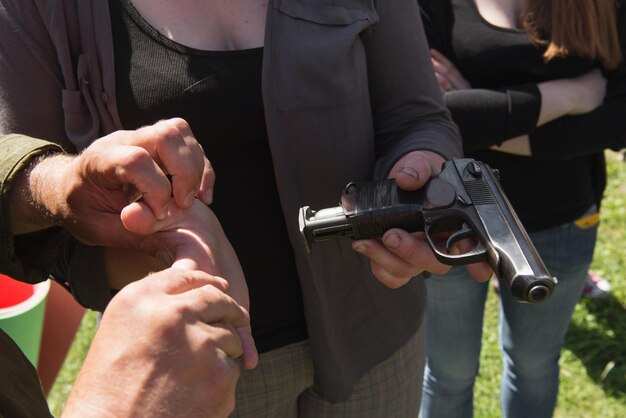Navigating Gun Ownership Transfers in California: A Comprehensive Guide
In a state as diverse and populous as California, the intricacies of gun ownership are a hot topic for both enthusiasts and casual owners alike. Whether you're selling a firearm, bequeathing it to a family member, or simply enhancing your knowledge, understanding how to transfer gun ownership in California is crucial.
Understanding California's Gun Laws
California's Unique Approach
California's gun laws are among the strictest in the United States, reflecting the state's commitment to public safety. Understanding these laws is fundamental before embarking on a gun transfer. Key aspects of the state's gun laws include background checks, mandatory waiting periods, and extensive documentation.
Who Needs to Know?
Whether you're a seasoned gun owner or new to firearms, comprehending these regulatory requirements is essential. You could be transferring a gun as part of an inheritance, selling to a friend, or purchasing from a private party—each with its own set of rules and forms to navigate.
Steps to Legally Transfer Gun Ownership
1. Types of Transfers
Private Party Transfers (PPT)
In California, a private party transfer is one of the common methods for transferring gun ownership. This involves two private individuals and mandates that the transfer be conducted through a licensed firearms dealer (FFL).
Intrafamilial Transfers
Intrafamilial transfers are transfers between immediate family members, allowing for a smoother process. Despite the reduced hassle, it's essential to still report these transfers to the California Department of Justice (DOJ).
Dealer Transfers
These occur when purchasing from a licensed gun dealer. The dealer handles the necessary paperwork, background checks, and waiting periods.
2. Background Checks and Waiting Period
Mandatory Checks
California state law requires background checks on all firearm transfers. This applies to every type of transfer, even among family members.
Waiting Period
Typically, there's a 10-day waiting period before the legal transfer of the firearm is complete. This period allows for the completion of background checks and ensures minimal risk in the transfer process.
3. Completing Forms and Documentation
Proper Documentation
Accurate and thorough documentation is crucial. This includes completing the Dealer’s Record of Sale (DROS) form, which the dealer submits to the DOJ.
Firearm Report Forms
For family transfers, completing and submitting an Intrafamilial Transfer Form or Firearm Ownership Report is necessary to inform the DOJ.
Key Considerations in Gun Transfers
Legal Restrictions and Eligibility
Prohibited Persons
Certain individuals, due to legal restrictions such as criminal history or mental health concerns, may be prohibited from owning a firearm. It's imperative to ensure that the transferee is legally eligible to possess a firearm.
Age Requirements
California mandates specific age requirements for gun ownership. Generally, purchasers must be 21 years or older.
Special Cases
Inheriting Firearms
If a firearm is bequeathed to a family member, the heir must file a Report of Operation of Law or Intra-Familial Firearm Transaction form with the DOJ, ensuring the transfer is recognized by the state.
Antique Firearms
Antique firearms, defined as those manufactured before 1899, may be exempt from some modern transfer laws but should still be properly documented to avoid potential legal issues.
FAQs on Gun Transfers
Can I transfer a gun without an FFL?
No. Even with private sales, an FFL must facilitate the transfer, ensuring compliance with background checks and documentation requirements.
What if I want to sell my gun out of state?
Federal Laws Apply
Transferring a firearm across state lines involves federal laws, often requiring the gun to be shipped to an FFL in the recipient's state.
How often can I sell my guns?
Limited Transactions
Private individuals are generally limited to selling a certain number of guns per year without being classified as a dealer, which requires a special license.
Table: Quick Reference Guide for Gun Transfers in California
| Transfer Type | Process Overview | Key Requirements |
|---|---|---|
| Private Party Transfer | Conduct transaction through a licensed dealer. | Background check, 10-day waiting period via DROS. |
| Intrafamilial Transfer | Simple transfer between immediate family; report to DOJ. | Complete appropriate DOJ forms. |
| Dealer Transfer | Purchase or transfer by a licensed dealer with all legal protocols managed by the dealer. | Dealer manages paperwork and waiting period. |
Practical Tips for Gun Transfers
- 🔒 Always Use an FFL: To ensure legality, use a licensed firearms dealer for all transfers.
- 🕐 Plan for the Waiting Period: Factor in the mandatory 10-day waiting period when planning a transfer.
- 📄 Complete All Required Forms: Missing paperwork can invalidate a transfer—don't skip the necessary documentation.
- 📋 Double-Check Eligibility: Verify that the buyer is legally permitted to own a firearm to avoid legal complications.
Closing Insight: Navigating the Landscape
Successfully navigating the gun ownership transfer process in California requires knowledge, patience, and diligence. By adhering to California's stringent laws and guidelines, gun owners can ensure safe and lawful transfers, contributing to the broader effort of responsible gun ownership and public safety. Stay informed, use authorized channels, and maintain detailed records as your key tools in this essential process.

Related Topics
- How Do You Transfer a Car Title To Someone Else
- How Long Does It Take To Transfer a Car Title
- How Much Does It Cost To Transfer a Car Title
- How Much Does It Cost To Transfer Title In Florida
- How Much Is It To Transfer a Title
- How Much Is It To Transfer a Title In Florida
- How Much Is It To Transfer a Title In Illinois
- How Much Is To Transfer a Car Title
- How Much To Transfer Car Title
- How Much To Transfer Title In Illinois